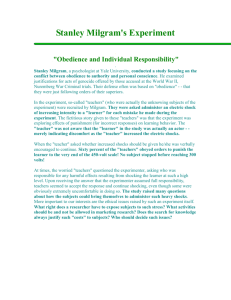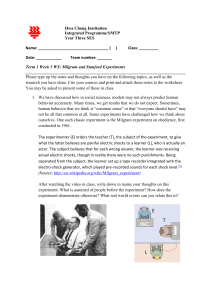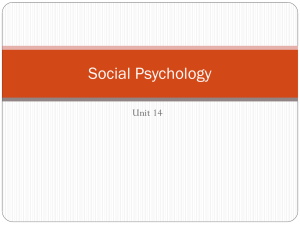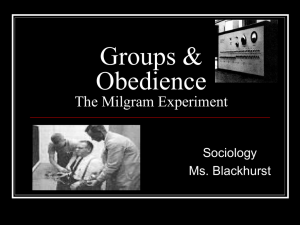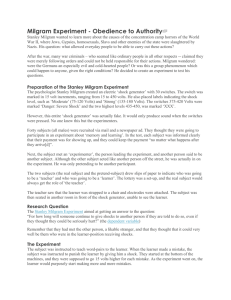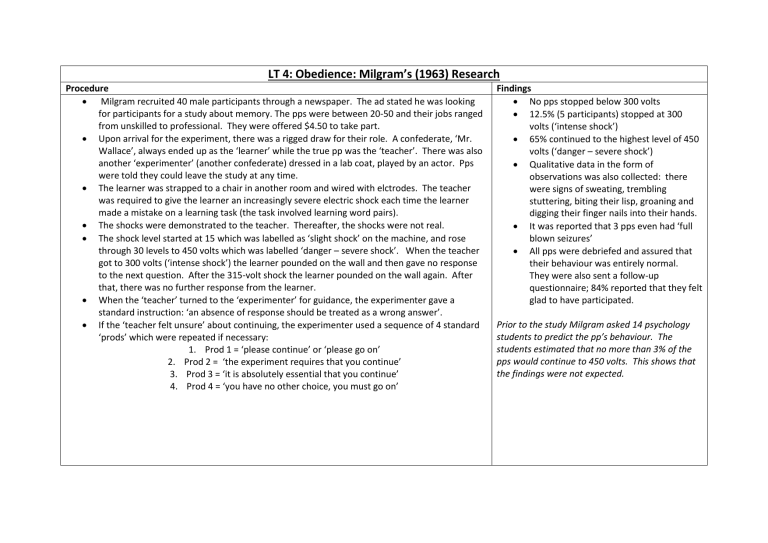
LT 4: Obedience: Milgram’s (1963) Research Procedure Milgram recruited 40 male participants through a newspaper. The ad stated he was looking for participants for a study about memory. The pps were between 20-50 and their jobs ranged from unskilled to professional. They were offered $4.50 to take part. Upon arrival for the experiment, there was a rigged draw for their role. A confederate, ‘Mr. Wallace’, always ended up as the ‘learner’ while the true pp was the ‘teacher’. There was also another ‘experimenter’ (another confederate) dressed in a lab coat, played by an actor. Pps were told they could leave the study at any time. The learner was strapped to a chair in another room and wired with elctrodes. The teacher was required to give the learner an increasingly severe electric shock each time the learner made a mistake on a learning task (the task involved learning word pairs). The shocks were demonstrated to the teacher. Thereafter, the shocks were not real. The shock level started at 15 which was labelled as ‘slight shock’ on the machine, and rose through 30 levels to 450 volts which was labelled ‘danger – severe shock’. When the teacher got to 300 volts (‘intense shock’) the learner pounded on the wall and then gave no response to the next question. After the 315-volt shock the learner pounded on the wall again. After that, there was no further response from the learner. When the ‘teacher’ turned to the ‘experimenter’ for guidance, the experimenter gave a standard instruction: ‘an absence of response should be treated as a wrong answer’. If the ‘teacher felt unsure’ about continuing, the experimenter used a sequence of 4 standard ‘prods’ which were repeated if necessary: 1. Prod 1 = ‘please continue’ or ‘please go on’ 2. Prod 2 = ‘the experiment requires that you continue’ 3. Prod 3 = ‘it is absolutely essential that you continue’ 4. Prod 4 = ‘you have no other choice, you must go on’ Findings No pps stopped below 300 volts 12.5% (5 participants) stopped at 300 volts (‘intense shock’) 65% continued to the highest level of 450 volts (‘danger – severe shock’) Qualitative data in the form of observations was also collected: there were signs of sweating, trembling stuttering, biting their lisp, groaning and digging their finger nails into their hands. It was reported that 3 pps even had ‘full blown seizures’ All pps were debriefed and assured that their behaviour was entirely normal. They were also sent a follow-up questionnaire; 84% reported that they felt glad to have participated. Prior to the study Milgram asked 14 psychology students to predict the pp’s behaviour. The students estimated that no more than 3% of the pps would continue to 450 volts. This shows that the findings were not expected. Demand Characteristics P: One issue with Milgram’s research into obedience is that it can be argued it may be subject to demand characteristics. E: For example, it was stated by Orne and Holland (1968) that participants behaved the way they did because they didn’t really believe in the set up – they guessed it wasn’t real electric shocks. This was later backed up by Perry (2013) who listened to recordings of Milgram’s research and reported that many of them expressed doubts about the shocks. E: This is an issue because if the participants were not convinced they were giving shocks and so only did it to go along with the research (i.e. showing demand characteristics) then Milgram’s internal validity is questioned, as he’s not actually measuring obedience. L: Overall the credibility of Milgram’s research into obedience is thrown into question. Evaluation of Milgram’s Research High External Validity P: One strength of Milgram’s study is that, although it was conducted in a lab, it does have high external validity. E: For example, Milgram explained that the central feature of this situation was the relationship between the authority figure (the experimenter) and the participant. Milgram argued that the lab environment accurately reflected wider authority relationships in real life. E: This is a strength because the processes of obedience to authority that occurred in Milgram’s lab study can be generalised to other situations. For example, Hofling et al (1966) studied nurses on a hospital ward and found that levels of obedience to unjustified demands by doctors were very high (with 21 out of 22 nurses obeying). So Milgram’s findings do have something valuable to tell us about how obedience operates in real life. L: Overall, this supportive research and explanation strengthen the external validity and the credibility of Milgram’s research. Ethical Issues P: One issue with Milgram’s research into obedience is that it breaches ethical issues. E: For example, the research had an element of deception, as Milgram originally advertised for volunteers to take part in a study into memory, not into obedience (the real aim), the allocation of roles was fixed, and the electric shocks weren’t real. E: This is an issue because the deception means that the participants were not fully aware of the true nature of the research, and leading the participants into thinking they were delivering potentially fatal shocks could have caused serious psychological distress (as noted previously) to the participants. L: However, although these ethical issues were breached, In research such as this a cost-benefit analysis is crucial because we must consider that furthering our knowledge of how people obey authority could be considered more important than the breaching of some of these ethical issues.
